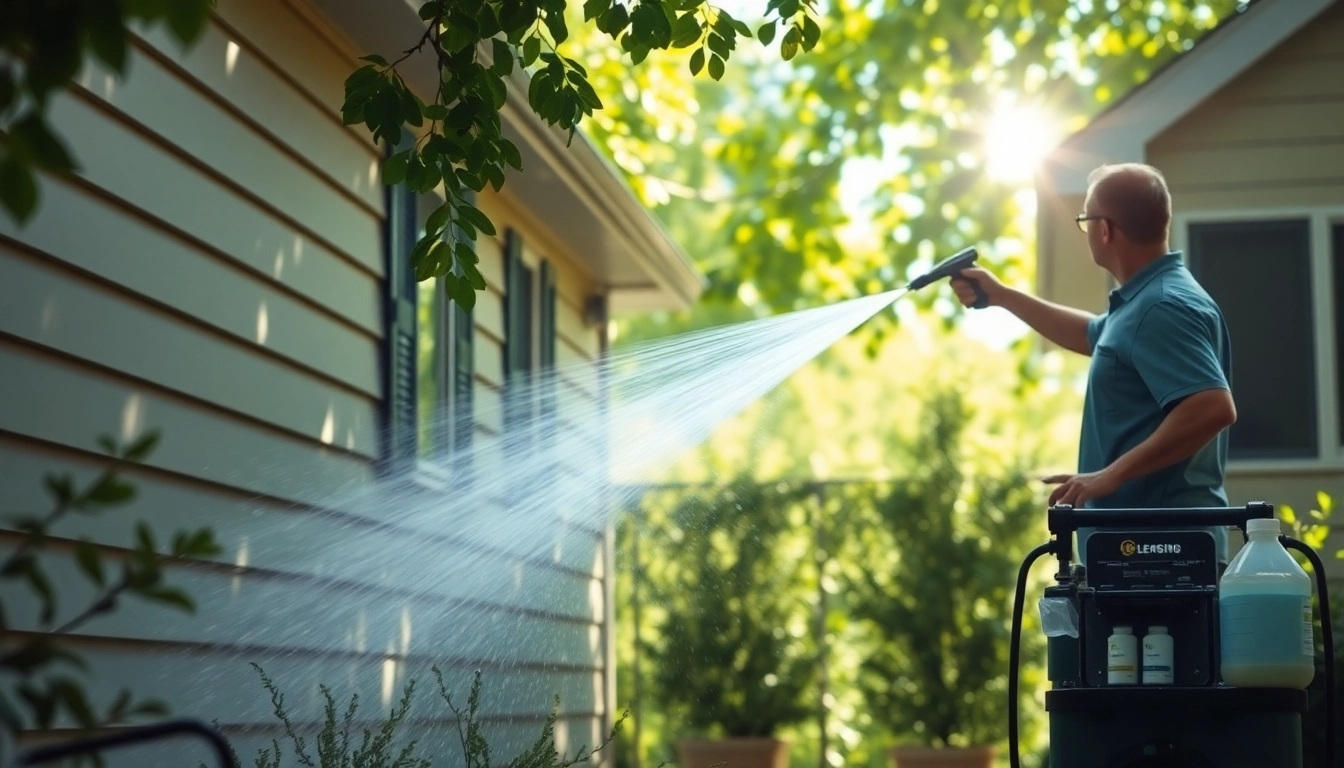The Ultimate Guide to Soft Washing: Transform Your Home Exteriors in 2024

What is Soft Washing? Understanding the Basics
Soft washing is a specialized cleaning method that employs low-pressure water along with a mixture of cleaning solutions to safely clean various surfaces, particularly exterior areas of homes and commercial properties. This technique proves to be extremely effective in removing dirt, organic stains such as algae, mildew, and other contaminants without damaging the surfaces being cleaned. Unlike conventional pressure washing, which could potentially harm certain materials due to high water pressure, soft washing minimizes risk while delivering superior results. If you are looking for effective cleaning methods for your property’s exterior, understanding soft washing is essential.
Definition and Benefits of Soft Washing
Soft washing is defined as a cleaning technique that utilizes a low-pressure stream of water, combined with specific biocides and surfactants, to disinfect and cleanse surfaces. This approach is particularly advantageous because it effectively removes algae, mold, mildew, and dirt buildup without the abrasive impact of high-pressure washing.
Some key benefits of soft washing include:
- Gentle on Surfaces: Soft washing prevents damage to delicate materials like shingles, vinyl siding, and stucco, making it ideal for a wide range of surfaces.
- Long-Lasting Results: The inclusion of biocides in the cleaning solution helps to eliminate not just visible dirt, but also the root causes of growth, thereby reducing the frequency of needed cleanings.
- Environmental Impact: Many soft washing solutions are biodegradable and environmentally safe, posing less risk to surrounding plants and wildlife.
- Cost-Effective: By extending the lifespan of exterior materials and reducing the need for frequent cleanings, soft washing can be a more cost-effective option in the long term.
How Soft Washing Differs from Pressure Washing
While both soft washing and pressure washing involve the use of water to clean surfaces, their methodologies are fundamentally different. Pressure washing uses high pressure to blast away dirt and grime, which can be effective on sturdy surfaces such as concrete. However, this method carries risks of damage, including etching, splintering, and bending softer materials.
In contrast, soft washing employs significantly lower water pressure, relying more on chemistry than brute force. This method effectively cleans surfaces while avoiding damage, making it the preferred choice for roofs, painted surfaces, and other sensitive applications.
Ultimately, the choice between soft washing and pressure washing should be guided by the specific material and desired outcome. Evaluating the condition of the surface and the nature of the contaminants will help you select the right method for your cleaning needs.
Common Applications of Soft Washing
Soft washing is versatile and applicable to various surfaces and settings. Its common applications include:
- Residential Roof Cleaning: Soft washing is widely used for cleaning roofs, effectively removing algae streaks and moss without risking damage to shingles.
- Exterior Walls: Often applied to sidings made of wood, vinyl, brick, and stucco, soft washing can restore the original appearance of home exteriors.
- Patio and Deck Cleaning: Soft washing is ideal for cleaning outdoor living spaces, leaving them looking clean and welcoming.
- Commercial Properties: Businesses often rely on soft washing to maintain their aesthetics, ensuring storefronts, awnings, and signage are spotless.
Essential Equipment for Soft Washing
Choosing the Right Soft Washing Machine
When selecting a soft washing machine, consider factors such as type, power, and reliability. There are generally two primary types of soft washing systems—electric and gas-powered units. Electric systems tend to have lower operating costs and are more suitable for residential applications, while gas-powered machines can deliver higher power for larger commercial jobs.
Look for machines that offer adjustable pressure settings to ensure customization based on cleaning needs. A system equipped with a downstream injector allows for easier mixing of cleaning solutions, enhancing efficiency.
Key Ingredients in Soft Washing Solutions
Soft washing solutions typically contain a combination of bleach, surfactants, and water. The bleach component helps to kill mold and mildew, while surfactants ensure effective dust and dirt removal. Here’s a breakdown of common components:
- Sodium Hypochlorite: The active ingredient in many soft washing solutions, sodium hypochlorite disinfects and removes organic stains.
- Surfactants: These play an essential role in breaking surface tension, allowing the solution to penetrate dirt and grime effectively.
- Water: Acts as the carrier for the cleaning solutions, facilitating their application and effectiveness.
Recommended Safety Gear for Technicians
Safety should always be a top priority when engaging in any form of cleaning. Technicians performing soft washing should be equipped with appropriate safety gear, such as:
- Protective Eyewear: Essential for preventing chemical splashes that can irritate the eyes.
- Gloves: Chemical-resistant gloves protect hands from exposure to potentially harmful substances.
- Respirator Mask: Helps to avoid inhaling fumes, particularly when using bleach-based solutions.
- Non-slip Footwear: Ensures safe movement on potentially slippery surfaces during cleaning.
The Soft Washing Process: Step-by-Step
Preparing Surfaces for Soft Washing
Before starting the soft washing process, proper preparation is crucial. Begin by removing any large debris such as leaves or branches from the surface area. Following that, assess the condition of the surface to identify areas requiring special attention.
If there are any significant health concerns (such as mold infestations), it might be necessary to consult with an expert prior to cleaning. Additionally, protect any surrounding plants or outdoor furniture that could potentially come into contact with the cleaning solution.
Applying the Soft Wash Mixture
Once the surfaces are prepped, it’s time to apply the soft wash solution. The steps for applying the mixture are as follows:
- Fill the soft washing machine with the prepared solution according to the manufacturer’s instructions.
- Begin spraying the solution on the surface from the bottom working your way up. This method prevents streaking as the solution will run down as it adheres to the surface.
- Allow the solution to dwell for approximately 10-15 minutes, giving it enough time to penetrate and do its job.
- Finally, rinse the surface thoroughly with low-pressure water, ensuring that all cleaning agents are washed off and the surface is left clean.
Post-Cleaning Care and Maintenance
After soft washing, it’s essential to provide post-cleaning care to maintain the appearance of clean surfaces. This may include:
- Regular Inspections: Check for any signs of mold or mildew returning and act swiftly.
- Routine Cleaning: Establish a maintenance schedule for routine soft washing every 1-2 years depending on local conditions.
- Educating Homeowners: Inform clients of best practices for preserving the cleanliness of their property, such as proper drainage and debris removal.
Challenges and Solutions in Soft Washing
Addressing Stubborn Stains
While soft washing is effective, certain stains may require extra attention. When dealing with stubborn stains such as graffiti or deeply embedded organic growth, additional cleaning agents or methods may be necessary. In some cases, agitation with brushes or cloths may assist in breaking down particularly tough stains.
Using an alternating solution with stronger biocides may also yield better results, but it’s important to ensure that these are safe for the surfaces being treated.
Dealing with Weather Conditions
Weather can pose significant challenges during the soft washing process. Ideally, soft washing should be performed on cloudy days to avoid rapid drying of the cleaning solution, which can lead to streaks and patchy areas of cleanliness. When temperatures are too cold, solutions may not perform effectively and could even freeze, causing damage to the surfaces.
To mitigate weather-related issues, it may be necessary to adjust scheduling according to forecasts, ensuring optimal conditions for cleaning.
Understanding Health and Safety Regulations
When using chemical solutions in soft washing, technicians must comply with local health and safety regulations. It’s vital to remain informed about the proper disposal of chemicals, as well as any licenses that may be required for specific chemical applications. Communicating with local environmental agencies can provide guidance on compliance.
Measuring Success: Performance Metrics for Soft Washing
Calculating Cost Effectiveness
Understanding the cost-effectiveness of soft washing is crucial not only for service providers but also for homeowners considering this cleaning method. Factors influencing costs include labor, materials, equipment, and surface area to be cleaned. A typical range for soft washing a two-story house is between $450 to $850, depending on square footage and the severity of staining. Regular maintenance can reduce the frequency and cost of cleaning services over time.
Evaluating Customer Satisfaction
Customer satisfaction is paramount in assessing the effectiveness of soft washing services. Feedback mechanisms, including surveys and reviews, provide insights into the client’s perception of the service provided. Metrics such as repeat business and referrals can indicate how effectively you meet client needs—and how likely they are to recommend your services to others.
Improving Techniques for Better Outcomes
Continuous improvement is key to achieving superior results in soft washing. Engaging in ongoing training and staying updated with the latest cleaning technologies can significantly enhance service outcomes. Technicians should also share best practices and tips among themselves to refine approaches and troubleshoot common challenges, thus providing a consistently high-quality service.






